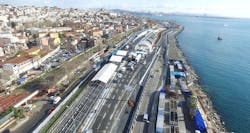Eurasia Tunnel opens to ease Istanbul's traffic congestion
The Eurasia Tunnel, connecting the Asian and European continents underneath the Marmara seabed, will be inaugurated today in front a multinational audience.
The tunnel, expected to provide a practical solution to Istanbul's traffic problem, will cut down the travel time between the two sides of Istanbul to just 15 minutes.
The bidding for the two-story tunnel project for rubber-wheeled vehicles followed the footsteps of the undersea rail tunnel Marmaray, and was held by the General Directorate of Infrastructure Investments of the Transport, Maritime Affairs and Communications Ministry on June 12, 2007.
The Eurasia Tunnel, which will significantly reduce the travel time between Istanbul's Kazlıçeşme on the European side and Göztepe on the Asian side, was planned in connection with the three existing bridges crossing the Bosporus strait.
The two-story tunnel, which is 14.5 km long, including a 5.4-km section under the Bosporus, has been constructed for rubber-wheeled vehicles only.
It will also reduce the travel time from 100 minutes to 15 minutes on a route with heavy traffic. While the traffic flow will become smoother thanks to the expansion and regulation of connection roads at the entrance and exit points of the tunnel, the tunnel will also help reduce environmental pollution and noise.
The construction on the tunnel began in 2011 and has cost an estimated $1.25 billion. It is estimated that 100,000 vehicles per day will use the tunnel, which was built 106 m under the Bosporus.
The General Directorate of Infrastructure Investments of the Ministry of Transport, Maritime Affairs and Communication selected Eurasia Tunnel Operation Construction and Investment Inc. (ATAŞ) to design, construct and operate the project for 24 years and five months. After 24 years, the tunnel will be transferred to the public.
